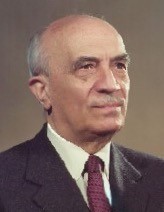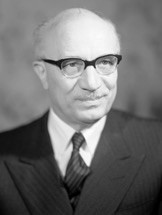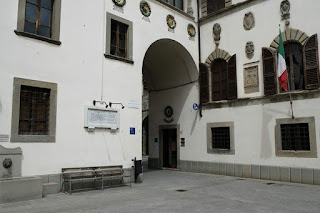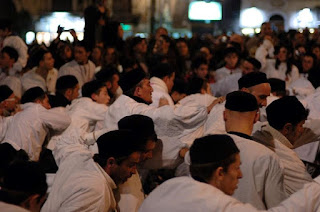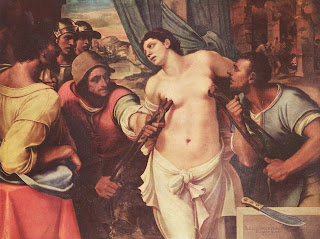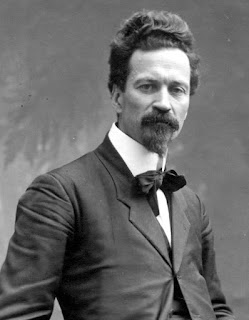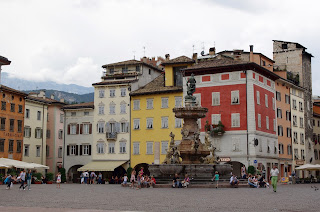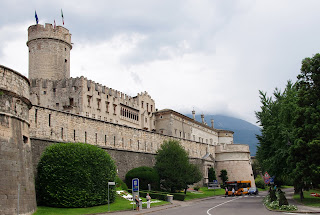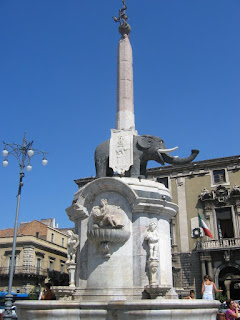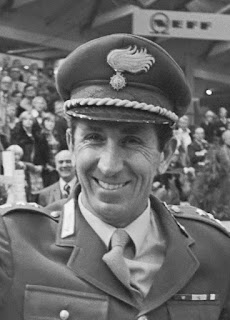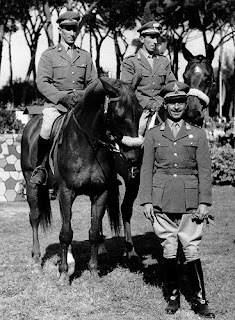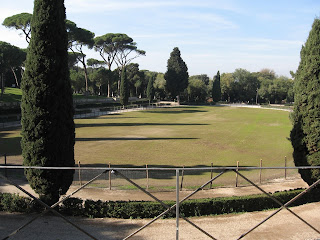Superb horseman helped keep the British at bay
 |
| Amedeo Guillet, pictured in his military dress uniform, was a brilliant horseman |
Amedeo Guillet, the last man to lead a cavalry charge against the British Army, was born on this day in 1909 in Piacenza.
His daring actions in Eritrea in 1941 were remembered by
some British soldiers as ‘the most frightening and extraordinary’ episode of
the Second World War.
It had seemed as though the British invasion of Mussolini’s
East African empire was going like clockwork. But at daybreak on January 21,
250 horsemen erupted through the morning mist at Keru, galloping straight
towards British headquarters and the artillery of the Surrey and Sussex
Yeomanry.
Red Italian grenades that looked like cricket balls exploded
among the defenders and the guns that had been pointing towards Italian
fortifications had to be quickly turned to face a new enemy.
The horsemen later disappeared into the network of wadis - ravines - that crisscrossed the Sudan-Eritrean lowlands.
Guillet’s actions at Keru helped the Italian army regroup
and go on to launch their best actions in the entire war. Guillet was to live
on until the age of 101 and become one of the most decorated people in Italian
history.
Guillet was born into a Savoyard-Piedmontese family, who
were minor aristocracy that had, for generations, served the Dukes of Savoy and
later the Kings of Italy.
 |
| Guillet in action on the battlefield in 1940 |
He spent most of his childhood in the south and said he
remembered the Austrian biplane bombing of Bari during the First World War. He
followed family tradition by joining the army and, after attending the military
academy at Modena, went into the cavalry.
Guillet excelled as a horseman and was selected for the
Italian eventing team to go to the Berlin Olympics in 1936. But Mussolini’s
invasion of Ethiopia interrupted his career as a competition rider.
He had himself transferred to a cavalry division and fought
repeated actions with them. He witnessed the aerial gas attacks on Emperor
Haile Selassie’s lightly-armed warriors, which appalled the world.
In Guillet’s opinion, gas was largely ineffectual against an
enemy that could flee. He fought with horse, sword and pistol. He suffered a
painful wound to his left hand and was later decorated for his actions.
He was flattered to be chosen by General Luigi Frusci as an
aide de camp, in the division sent to support Franco in the Spanish Civil War,
where he suffered shrapnel wounds, but helped to capture three Russian armoured
cars and crews.
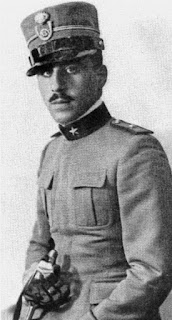 |
| Guillet disapproved of the pro- Nazi alliance and anti-semitism |
But he disapproved of the pro-Nazi alliance and the
anti-Semitic race laws adopted by Italy and asked for a posting to East Africa,
where a family friend, Amedeo Duke of Aosta, had been appointed viceroy.
Mussolini’s decision to enter the war on the side of Germany
in 1940 cut off Italian East Africa, which was surrounded by the territories of
its enemies. Aosta gave Guillet command of 2,500 men, both cavalry and
infantry. With almost no armour, Guillet’s horsemen were used to delay the
British advance.
His actions at Keru and in subsequent battles won time for
the Italian army, but eventually the British broke through. Most of the Italian
army surrendered but Guillet refused to do so.
Aosta ordered his men to fight on to keep as many British
soldiers as possible in East Africa.
For nine months Guillet launched a series of guerrilla
actions against British troops with his mistress, Khadija, an Ethiopian Muslim,
at his side. He believed he would never see Italy, or the woman he had planned
to marry there, ever again.
Two British intelligence officers pursued him. One of them,
Major Max Harrari, would later become an art dealer and one of his close
friends. But Guillet managed to escape across the sea to neutral Yemen where he
became a friend of the ruler Imam Ahmed. He sneaked back to Eritrea in 1943 in
disguise, from where he returned to Italy on the Red Cross ship, Giulio Cesare.
He married his Neapolitan cousin, Beatrice Gandolfo, in 1944
and spent the rest of the war as an intelligence officer.
At the end of the war, after the decision to abolish the
monarchy in Italy, Guillet told Umberto II he intended to leave the country for
good, but the deposed King asked him to keep serving Italy, whatever sort of
Government was installed.
 |
| Despite being wounded many times, Guillet not only survived his wartime experiences but lived to be 101 years old |
Guillet joined the diplomatic service and because his Arabic
was fluent he served in the Middle East. He was later ambassador in Jordan,
Morocco and India.
In 1975 he retired and went live in County Meath in Ireland
to enjoy the fox hunting.
According to his biographer, Sebastian O’Kelly, Guillet was
‘a kind, generous man who thought himself lucky to have survived many bullet
and grenade wounds, sword injuries and bone fractures.’ Guillet’s wife,
Beatrice, died in 1990.
In 2000, Guillet was presented with the Knight Grand Cross
of the Military Order of Italy, the highest military decoration, by President
Carlo Azeglio Ciampi.
Guillet’s life story was the subject of a film made by
Elisabetta Castana for the national TV channel RAI in 2007.
In 2009 he was still well enough to be able to celebrate his
100th birthday at the army officers’ club in Palazzo Barberini in Rome.
When Guillet died in June 2010 in Rome he was widely
respected as one of the last men to have commanded cavalry in a war.
 |
| One of Francesco Mochi's statues in Piacenza |
Travel tip:
Piacenza, where Guillet was born, is a city in the
Emilia-Romagna region of northern Italy. The main square in Piacenza is named
Piazza Cavalli because of its two bronze equestrian monuments featuring
Alexander Farnese, Duke of Parma and his son Ranuccio I Farnese, Duke of Parma,
who succeeded him. The statues are masterpieces by the sculptor Francesco
Mochi.
 |
| The Palazzo Barberini in Rome |
Travel tip:
Palazzo Barberini, where Guillet celebrated his 100th
birthday, is just off Piazza Barberini in the centre of Rome. The palace was
completed in 1633 for Pope Urban VIII to the design of three great architects,
Carlo Maderno, Francesco Borromini and Gian Lorenzo Bernini.
